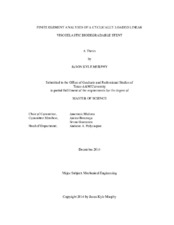| dc.description.abstract | Biodegradable polymers have been in use for biomedical applications such as sutures and various implants for many years. In the recent decade, research into the development of biodegradable cardiac stents has expanded. This is due to a need for a stent to perform its job and then be removed from the site of implantation, as up to 20% of all cases require re-intervention after 6 – 12 months due to in-stent restenosis, as reported in 2010.
In this study, the effect of viscoelastic and mechanical degradation behaviors on the performance of cylindrical annuli that mimic stents under cyclic loadings is examined. Two polymers are considered: poly-L-lactic acid (PLLA) and polyoxymethylene (POM). A numerical algorithm for an isotropic, linear, viscoelastic material with inclusion of degradation is developed and incorporated into the finite element software ABAQUS/CAE via a user-defined material subroutine (UMAT). A constant pressure meant to mimic the arterial wall’s resistance to expansion is coupled with a cyclic pressure equivalent to an ideal resting blood pressure. The degradation considered is defined as strain-induced. Loading is applied under two cases. A linearly ramped loading is first studied, followed by a creep-cyclic study.
Circumferential stresses and strains, along with the degradation, are presented for both a simplified cylindrical annulus, as well as two typical real-world stent geometries. It is seen that not only do material properties affect deformation, but geometrical properties have a large effect as well. The uniform stresses and strains developed in the cylindrical annulus are far less than the non-uniform stresses and strains observed in the realistic stent geometries. This is due to localized stress and strains at the junctions in the mesh of the realistic geometries, where stress concentrations are a maximum. As predicted by the time-dependent material properties given for each material from previous experimental studies, the stresses, strains, and degradation observed are strongly dependent on the time-dependent material behaviors. | en |


